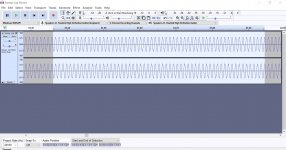Mooly, didn't see your reply. I don't have a scope unfortunately, mate. It's reassuring that you say the components shouldn't effect the bass.
I suggest the obvious: use an 18V Zener diode as in the schematic.
Obvious you maybe, Jean-Paul! Not to me 😀
I will order some 18v Zener diodes and give it a go.
Thanks
Also to you as you can see in the schematic. You would not use 20” wheels when your car has 13” wheels off factory would you!?
Also just 1 change (of a part that has not the same value as the original value) is easier and less risk than reversing the other choices which probably are not the cause. A 3V difference between Zeners is more likely to have impact. Simple Logic.
Also just 1 change (of a part that has not the same value as the original value) is easier and less risk than reversing the other choices which probably are not the cause. A 3V difference between Zeners is more likely to have impact. Simple Logic.
Last edited:
Mooly, didn't see your reply. I don't have a scope unfortunately, mate. It's reassuring that you say the components shouldn't effect the bass.
The transistors definitely 100% won't alter the bass but passive parts will if you get a wrong value in there somewhere.
It's really seriously lacking in bass so I think I'm going to have to try other things.
That's quite a statement and needs proving/disproving. A scope is the single most useful bit of test gear you can own tbh.
Many DVM's have a decent response over differing frequency AC voltage but you would need to look at the meter specification to see. You could do a very slow sweep and check the output voltage is constant. Most meters would be good over the lower frequency end.
If you want a slow MP3 frequency sweep I can post one here.
You haven't got the speakers out of phase have you?
The speakers are definitely in phase. I will try the frequency sweep if you don't mind, Mooly. I can't find any detailed specs for my DVM but il give it a go.
I've ordered some 18v Zeners as well so will swap that out when they arrive.
I've ordered some 18v Zeners as well so will swap that out when they arrive.
Here you go. This MP3 plays for 3 minutes and covers 20Hz to 20kHz. The level is quite high so make sure the volume is turned right down to begin. Once you are happy with the 'sound' which should be pure with no distortion then you can disconnect the speaker and turn the volume up to say 3 to 4 volts (AC remember). Then see if the level alters through the sweep.
Try both channels and perhaps also a different amp to gauge your meter response. Best guaranteed meter accuracy will be up to at least 500Hz or so and many meters are OK over the full audio range.
You could also try measuring the input voltage (from whatever you play the file on) as a double check on response.
The track is a single mono track to save space.
Try both channels and perhaps also a different amp to gauge your meter response. Best guaranteed meter accuracy will be up to at least 500Hz or so and many meters are OK over the full audio range.
You could also try measuring the input voltage (from whatever you play the file on) as a double check on response.
The track is a single mono track to save space.
Attachments
Here you go. This MP3 plays for 3 minutes and covers 20Hz to 20kHz. The level is quite high so make sure the volume is turned right down to begin. Once you are happy with the 'sound' which should be pure with no distortion then you can disconnect the speaker and turn the volume up to say 3 to 4 volts (AC remember). Then see if the level alters through the sweep.
Try both channels and perhaps also a different amp to gauge your meter response. Best guaranteed meter accuracy will be up to at least 500Hz or so and many meters are OK over the full audio range.
You could also try measuring the input voltage (from whatever you play the file on) as a double check on response.
The track is a single mono track to save space.
Thanks, Mooly. I'll let you know how I get on.
And...
(You did extract the file first rather than try and play the zipped contents? or I wonder if it being a mono (single) track is why it wasn't playable. Any PC or laptop should play it from which you could use the line output)
(You did extract the file first rather than try and play the zipped contents? or I wonder if it being a mono (single) track is why it wasn't playable. Any PC or laptop should play it from which you could use the line output)
It played the file but it was a really fast sweep so not sure if it was an issue with my phone and the mp3 codec or something...
Anyway, no results as I've managed somehow to blow the 1.25A fuse so will have to wait until tommorow to go to the elec wholesaler 🙁
I've actually blown 2! I had a spare to put that in and tried again. When I replaced it playback was fine so tried the tone generator again with the speaker disconnected but it's blown again. Had the voltage ac at around 4v on the VM.
Will try again tomorrow.
Anyway, no results as I've managed somehow to blow the 1.25A fuse so will have to wait until tommorow to go to the elec wholesaler 🙁
I've actually blown 2! I had a spare to put that in and tried again. When I replaced it playback was fine so tried the tone generator again with the speaker disconnected but it's blown again. Had the voltage ac at around 4v on the VM.
Will try again tomorrow.
It shouldn't be blowing fuses and certainly not with no speakers attached.
4vrms at the output would only be 2 watts rms into 8 ohm loading even if you did have the speaker connected although it would be deafeningly loud at that on a test tone.
It is important that the tone is a pure sine and not a squarewave which could do nasty things at higher levels. A sine is easily identifiable audibly as it is really pure with no harmonics.
4vrms at the output would only be 2 watts rms into 8 ohm loading even if you did have the speaker connected although it would be deafeningly loud at that on a test tone.
It is important that the tone is a pure sine and not a squarewave which could do nasty things at higher levels. A sine is easily identifiable audibly as it is really pure with no harmonics.
I think I'll try downloading it on my laptop. The 3.5mm output socket is a bit flakey which is why I tried it on the phone. Hopefully the elec wholesaler will have some 1.25V fuses, have ordered some online as well but I'm impatient!
I have just opened it on my Ubuntu PC, I have a speakers in this same room so I think I'll bring the amp up here for testing tommorow.
I think in hindsight, I probably heard it how it's supposed to sound on the phone this morning. I think I was probably expecting the lower tones to be heard for longer, if that makes sense? It's 3 mins long but the bass tones are over in the first couple of seconds.
I think the fuses blew once I played the tone with just the Voltmeter but without the speakers connected.
I'll report back once I've given it another go.
Thanks 🙂
I think in hindsight, I probably heard it how it's supposed to sound on the phone this morning. I think I was probably expecting the lower tones to be heard for longer, if that makes sense? It's 3 mins long but the bass tones are over in the first couple of seconds.
I think the fuses blew once I played the tone with just the Voltmeter but without the speakers connected.
I'll report back once I've given it another go.
Thanks 🙂
Fair comment 🙂
Try this, its the same thing but now stereo (two track) and crucially with a logarithmic sweep. The bass frequency increase starts off slowly and you may not hear anything until you get 30 or 40 seconds into it if playing on a laptop.
Even at 40 seconds in its only around 100Hz.
Try this, its the same thing but now stereo (two track) and crucially with a logarithmic sweep. The bass frequency increase starts off slowly and you may not hear anything until you get 30 or 40 seconds into it if playing on a laptop.
Even at 40 seconds in its only around 100Hz.
Attachments
Great stuff. Thanks again, Mooly. Really do appreciate everyones help!
Fingers crossed for fuses tommorow 🙂
Fingers crossed for fuses tommorow 🙂
- Home
- Amplifiers
- Solid State
- Toshiba 330 power amp


